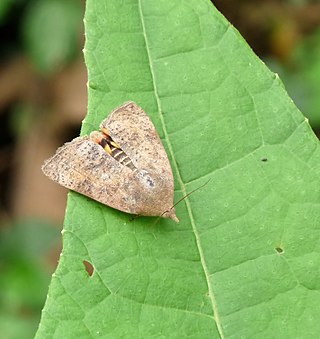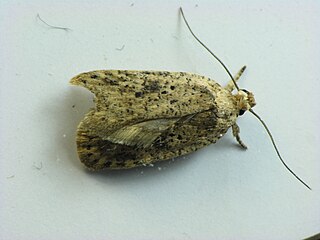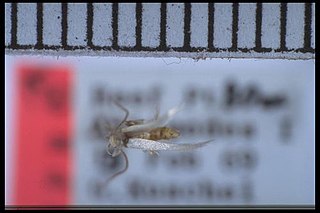
The Elachistidae are a family of small moths in the superfamily Gelechioidea. Some authors lump about 3,300 species in eight subfamilies here, but this arrangement almost certainly results in a massively paraphyletic and completely unnatural assemblage, united merely by symplesiomorphies retained from the first gelechioid moths.

Hyblaeidae are the "teak moths", a family of insects in the Lepidopteran order. The two genera with about 18 species make up one of the two families of the Hyblaeoidea superfamily, which in the past has been included in the Pyraloidea. Recent phylogenetic studies find varying relationships of Hyblaeoidea among Ditrysian Lepidoptera: Mutanen et al. (2010) find the superfamily to group either with Pyraloidea, or – more often – with Thyridoidea or butterflies. The results of Wahlberg et al. (2013) and Heikilä et al. (2015) indicate a sister-group relationship with Pyraloidea.

The Batrachedridae are a small family of tiny moths. These are small, slender moths which rest with their wings wrapped tightly around their bodies.

Pterolonchidae is a small family of very small moths in the superfamily Gelechioidea. There are species native to every continent except Australia and Antarctica.

Arctia villica, the cream-spot tiger, is a moth of the family Erebidae. The species was first described by Carl Linnaeus in his 1758 10th edition of Systema Naturae. It is distributed from the Iberian Peninsula, Anatolia, western and northern Iran, western Siberia, southwestern Asia and North Africa.

Elachista is a genus of gelechioid moths described by Georg Friedrich Treitschke in 1833. It is the type genus of the grass-miner moth family (Elachistidae). This family is sometimes circumscribed very loosely, including for example the Agonoxenidae and Ethmiidae which seem to be quite distinct among the Gelechioidea, as well as other lineages which are widely held to be closer to Oecophora than to Elachista and are thus placed in the concealer moth family Oecophoridae here.

Depressariidae is a family of moths. It was formerly treated as a subfamily of Gelechiidae, but is now recognised as a separate family, comprising about 2,300 species worldwide.

Perittia is a genus of moths of the family Elachistidae.
Coelopoeta is a relatively divergent genus of small moths in the superfamily Gelechioidea, which have only been found in western North America.
Coelopoeta glutinosi is a tiny species of moth in the superfamily Gelechioidea. It is found in California in the United States.
Coelopoeta phaceliae is a moth in the superfamily Gelechioidea. It is found in the US state of California.
Apantesis yukona is a moth of the subfamily Arctiinae. It was described by Schmidt in 2009. It is found in Yukon. The habitat consists of dry, rocky or eroding south-facing slopes.
Arctia subnebulosa is a moth of the family Erebidae. It was described by Harrison Gray Dyar Jr. in 1899. It is found in Alaska, Yukon and the Russian Far East.
Elachista arthadella is a moth of the family Elachistidae first described by Lauri Kaila in 1999. It is found in the United States, where it has been recorded from Oregon.
Elachista cicadella is a moth of the family Elachistidae. It is found in Canada, where it has been recorded from Yukon.

Elachista antipodensis is a moth in the family Elachistidae. It was first described by John S. Dugdale in 1971. It is found on the Antipodes Islands.

Elachista eurychora is a species of moth in the family Elachistidae. This species is endemic to New Zealand and has only been collected at Paekākāriki. The habitat where the adult moth was originally collected was in rough vegetation on coastal sandhills or dunes but the collection locality has been significantly modified since that time. It has been hypothesised that the host of the larvae of this species is a grass. Adults are on the wing in March. It is classified as "Data Deficient" by the Department of Conservation.
Epimarptidae was a former, or is a possible, monotypic family of moths in the moth superfamily Gelechioidea. It can now be seen as either a synonym of family Batrachedridae, or a monotypic subfamily of that family.
Lauri Kaila is a Finnish entomologist and researcher of biodiversity, specializing in Lepidoptera, at the Finnish Museum of Natural History of the University of Helsinki. As of 2019, Kaila authored 324 species within the family of Elachistidae.

Zapyrastra stellata is a species of moth of the family Momphidae first described by Alfred Philpott in 1931. It is endemic to New Zealand and has been observed in Otago. The larvae of this species mine the leaves of Meuhlenbeckia. Adults are on the wing in June and December.










